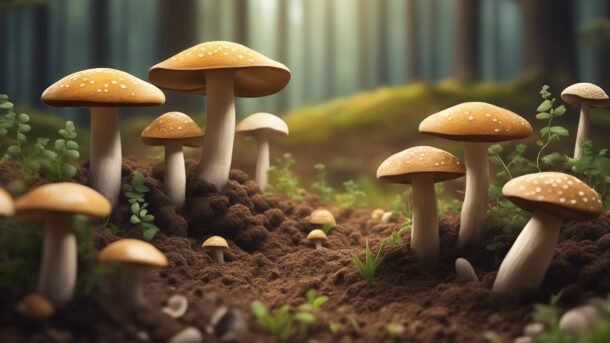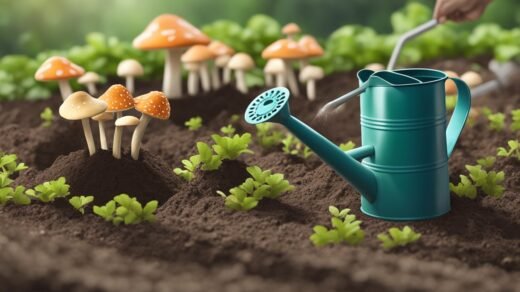Porcini mushrooms are a delicious and highly sought-after ingredient in many dishes. They are known for their meaty texture and savory taste, making them a favorite among chefs and food enthusiasts alike. Growing porcini mushrooms at home is a great way to ensure a fresh supply of this delicacy, and it can be done with relative ease.
To grow porcini mushrooms, one must first understand the basics of mushroom cultivation. It is important to create a suitable environment for the mushrooms to grow in, which includes providing the right amount of moisture, temperature, and light. Porcini mushrooms prefer a cool, damp environment with temperatures between 55-65°F (12-18°C), making them ideal for growing in a basement or cellar.
There are several methods for growing porcini mushrooms, including using spores, spawn, or kits. Each method has its own advantages and disadvantages, and it is important to choose the method that best suits your needs and experience level. With the right conditions and a little patience, anyone can successfully grow porcini mushrooms at home and enjoy the delicious taste of this delicacy.
Understanding Porcini Mushrooms

Species Identification
Porcini mushrooms, also known as Boletus edulis, are a type of wild mushroom that is highly prized for its rich, meaty flavor. They are easily identifiable by their broad, brown caps and thick, white stems. The caps of porcini mushrooms can grow up to 12 inches in diameter, while the stems can reach up to 8 inches in length. The underside of the cap is covered in small, porous tubes instead of gills, which is another identifying feature of this mushroom.
Natural Habitat
Porcini mushrooms are native to Europe and can be found growing in the wild in deciduous and coniferous forests. They are also commonly found in North America, Asia, and Africa. Porcini mushrooms prefer to grow in soil that is rich in organic matter, such as leaf litter or decomposing wood. They are often found growing near oak, chestnut, and pine trees.
It is important to note that while porcini mushrooms are highly sought after for their culinary value, they should only be harvested by experienced foragers or purchased from reputable sources. There are several toxic lookalike mushrooms that can be easily mistaken for porcini mushrooms, which can cause serious illness or even death if consumed.
Cultivation Requirements

Soil Conditions
Porcini mushrooms require a well-draining soil that is rich in organic matter. The soil pH should be between 6.0 and 7.5. The presence of their preferred tree species, such as oak, beech, and chestnut, is also crucial for successful cultivation. Porcini mushrooms form a symbiotic relationship with these trees, and their mycelium network grows around the roots.
Temperature and Humidity
The environmental conditions, including temperature and humidity, play a crucial role in the successful cultivation of porcini mushrooms. The optimal temperature for porcini mushroom growth ranges from 18°C to 24°C. The humidity level should be maintained at around 70% to 85%. It is essential to keep the growing environment cool and moist to prevent the growth of competing fungi.
To maintain the required temperature and humidity levels, it is recommended to grow porcini mushrooms indoors or in a greenhouse. A controlled environment ensures that the growing conditions remain consistent and favorable for the mushroom’s growth.
In summary, porcini mushrooms require a well-draining soil rich in organic matter, the presence of their preferred tree species, and a controlled growing environment with optimal temperature and humidity levels. By meeting these cultivation requirements, one can successfully grow porcini mushrooms.
Growing Techniques
Spore Collection
Before growing porcini mushrooms, it is essential to collect their spores. Spores can be obtained by purchasing them from a reputable supplier or collecting them from mature mushrooms. To collect spores, place a mature mushroom cap on a piece of paper or foil with the gills facing down. Cover the cap with a glass or bowl and leave it overnight. The spores will drop onto the paper or foil, which can then be used for inoculation.
Substrate Preparation
Porcini mushrooms grow best in a substrate that is rich in nutrients. A good substrate can be made by combining sawdust, bran, and water. The mixture should be heated to sterilize it and then allowed to cool before use. Once the substrate has cooled, it should be placed in a container and covered with a layer of plastic wrap to keep it moist.
Inoculation Method
There are several methods for inoculating porcini mushroom spores into the substrate. One method is to mix the spores with the substrate and then place the mixture in a container. Another method is to use spawn, which is a mixture of mycelium and substrate that has already been colonized by the mushroom. The spawn can be mixed with the substrate or placed on top of it. After inoculation, the container should be kept in a dark, humid place with a temperature of around 55-65°F (12-18°C).
Porcini mushrooms require a lot of care and attention during the growing process. It is important to maintain a consistent temperature and humidity level, as well as provide adequate ventilation. With the right growing techniques, however, it is possible to produce a bountiful crop of delicious porcini mushrooms.
Care and Maintenance
Watering Practices
Porcini mushrooms require consistent moisture levels to grow properly. The soil should be kept damp, but not too wet, to prevent waterlogging and fungal growth. Watering should be done regularly, and the soil should never be allowed to dry out completely. A good rule of thumb is to water the soil when it feels dry to the touch.
It is important to use clean water when watering the mushrooms. Tap water can contain chlorine and other chemicals that can harm the mushrooms. Rainwater or distilled water are good alternatives.
Controlling Pests and Diseases
Porcini mushrooms are susceptible to various pests and diseases, which can affect their growth and quality. The following are some tips on how to control pests and diseases:
- Keep the growing area clean and free of debris. This will prevent the buildup of harmful fungi and bacteria.
- Avoid overcrowding the mushrooms, as this can lead to the spread of disease.
- Remove any mushrooms that show signs of disease or pests, and dispose of them properly.
- Use organic fungicides and pesticides to control pests and diseases. Chemicals can harm the mushrooms and the environment.
Regular monitoring of the mushrooms for signs of pests and diseases is essential for their care and maintenance. Early detection and treatment can prevent the spread of pests and diseases and ensure healthy mushroom growth.
Harvesting and Storage
Harvesting Guidelines
Harvesting porcini mushrooms can be a bit tricky, but with the right knowledge and techniques, it can be done successfully. When harvesting porcini mushrooms, it is important to look for the following characteristics:
- The cap should be firm and intact, with no signs of damage or decay.
- The stem should be sturdy and thick, with no signs of rot or insect damage.
- The pores on the underside of the cap should be open and visible, indicating that the mushroom is mature and ready to be harvested.
When picking porcini mushrooms, it is important to use a sharp knife to cut the stem at the base of the cap. This will help to ensure that the mushroom is not damaged and will continue to grow in the future.
Drying and Preservation
Porcini mushrooms can be preserved for later use by drying them. To dry porcini mushrooms, follow these steps:
- Clean the mushrooms by wiping them with a damp cloth or brushing them lightly to remove any dirt or debris.
- Cut the mushrooms into thin slices and spread them out on a drying rack or a baking sheet lined with parchment paper.
- Place the rack or baking sheet in a warm, dry place with good ventilation, such as an oven with the door cracked open or a dehydrator.
- Allow the mushrooms to dry completely, which can take anywhere from a few hours to a few days depending on the humidity and temperature.
- Once the mushrooms are dry, store them in an airtight container in a cool, dry place.
Dried porcini mushrooms can be rehydrated by soaking them in warm water for about 30 minutes before use. They can be used in a variety of dishes, including soups, stews, risottos, and pasta dishes, to add a rich, earthy flavor.




